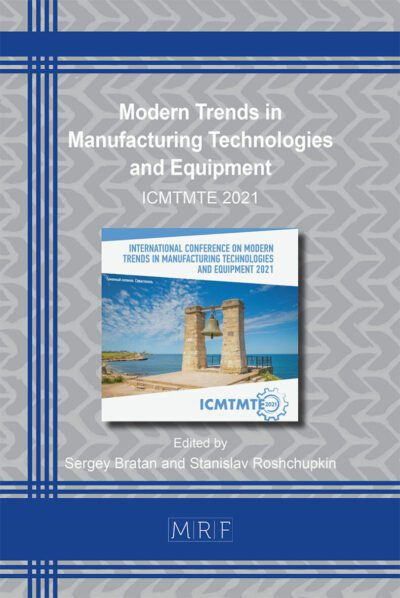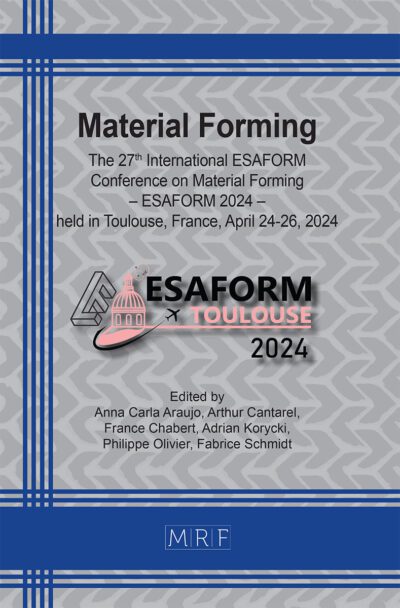Injection compression molding of wood powder mixed with natural binder
Ryo Kawase, Takashi Kuboki, Shohei Kajikawa
Abstract. Conventional injection cannot adequately fill wood powder in the mold due to the intergranular friction. To solve these problems, we proposed an injection compression molding technique for wood powder with a natural binder composed of sucrose and citric acid. The effect of the additional pressure from the rear on the moldability and the mechanical properties of the molded product was investigated. By applying pressure from the rear, the molded product became darker in appearance, and its density increased by approximately 20%, approaching the true density of wood. Furthermore, its hardness reached a level comparable to that of polyvinyl chloride (PVC). This result indicated that the rear pressure is effective in improving the moldability and mechanical properties of the molded product.
Keywords
Wood Powder, Injection Molding, Natural Binder
Published online 5/7/2025, 6 pages
Copyright © 2025 by the author(s)
Published under license by Materials Research Forum LLC., Millersville PA, USA
Citation: Ryo Kawase, Takashi Kuboki, Shohei Kajikawa, Injection compression molding of wood powder mixed with natural binder, Materials Research Proceedings, Vol. 54, pp 2503-2508, 2025
DOI: https://doi.org/10.21741/9781644903599-270
The article was published as article 270 of the book Material Forming
![]() Content from this work may be used under the terms of the Creative Commons Attribution 3.0 license. Any further distribution of this work must maintain attribution to the author(s) and the title of the work, journal citation and DOI.
Content from this work may be used under the terms of the Creative Commons Attribution 3.0 license. Any further distribution of this work must maintain attribution to the author(s) and the title of the work, journal citation and DOI.
References
[1] T. Miki, Advanced Material Processing System for Wood Resources Maximizing Carbon Storage Effect Aiming at Carbon Neutrality by 2050, Bulletin of the JSTP. 7 (2024) 1-3. https://doi.org/10.32277/plastos.7.73_1
[2] Á. Csikós, G. Faludi, A. Domján, K. Renner, J. Móczó, B. Pukánszky, Modification of interfacial adhesion with a functionalized polymer in PLA/wood composites, European Polymer Journal 68 (2015), 592-600. https://doi.org/10.1016/j.eurpolymj.2015.03.032
[3] Tao, X., Nonaka, H., Wet extrusion molding of wood powder with hydroxy-propylmethyl cellulose and with citric acid as a crosslinking agent, BioResources 16 (2021), 2314-2325. https://doi.org/10.15376/biores.16.2.2314-2325
[4] S. Kajikawa and T. Iizuka, Effect of water-soluble components mass on the fluidity of the steam-treated bamboo powder caused by heating and compression, Journal of the Society of Materials Science, 5 (2015) 381-386. https://doi.org/10.2472/jsms.64.381
[5] K. Umemura, O. Sugihara and S. Kawai, Investigation of a new natural adhesive composed of citric acid and sucrose for particleboard, Journal of Wood Science, 59 (2013) 203-208. https://doi.org/10.1007/s10086-013-1326-6
[6] K. Umemura, O. Sugihara and S. Kawai, “Investigation of a new natural adhesive composed of citric acid and sucrose for particleboard II: effects of board density and pressing temperature’’, Journal of Wood Science, 61 (2015) 40-44.
https://doi.org/10.1007/s10086-014-1437-8
[7] S.Kajikawa, M. Horikoshi, T. Kuboki, S. Tanaka, K. Umemura, K. Kanayama, Fabrication of naturally derived wood products by thermal flow molding of wood powder with sucrose and citric acid, BioResources 15 (2020), 1702-1715. https://doi.org/10.15376/biores.15.1.1702-1715
[8] S. Kajikawa, K. Cho, T. Kuboki, S. Tanaka, K. Umemura, K. Kanayama, Effect of particle size on thermal flow of Japanese ceder powder combined with sucrose and citric acid, Journal of the Society of Materials Science. 69 (2020) 440-445. https://doi.org/10.2472/jsms.69.440
[9] U.S. Department of Agriculture, Forest Service, Forest Products Laboratory, Wood Handbook: Wood as an Engineering Material, (2010). https://doi.org/10.2737/FPL-GTR-190
[10] B. Anshari, Z.W. Guan, A. Kitamori, K. Jung, I. Hassel, K. Komatsu, Mechanical and moisture-dependent swelling properties of compressed Japanese cedar, Construction and Building Materials. 25 (2011) 1718-1725. https://doi.org/10.1016/j.conbuildmat.2010.11.095













